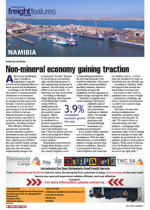Amid booming cross-border trade, Transworld Cargo is expanding its regional footprint with a series of strategic investments and agile service offerings. From a multimillion-dollar facility outside the Port of Walvis Bay to a fast-growing courier service connecting Namibia with Johannesburg and Cape Town, the company is capitalising on its f lexible, customer-first approach and deep-rooted knowledge of African logistics.Backed by its own trucks, rail siding and cold chain infrastructure, Transworld Cargo has become a key logistics player for sectors ranging from fresh produce and fish to copper, oil and gas, and abnormal loads. As the region experiences an increase in cargo volumes – particularly from neighbouring Zambia and Botswana – the company is positioning itself not just as a Namibian logistics provider but as a true through-port facilitator for southern Africa.According to Fritz Kaufmann, business developer at Transworld Cargo, Namibia is on a clear growth trajectory and has experienced a major inf lux of cargo in recent months. “We have offerings that make us very competitive and attractive to shippers, with a wide range of integrated services. Our new courier service, launched at the end of March, has been very well received by the industry. We’ve also expanded our footprint in the breakbulk and project cargo sectors, particularly on the back of the growing oil and gas industry.”He noted that the company had made significant investments in its cold storage capabilities and was now moving hundreds of thousands of cases of grapes and other fresh produce out of Zambia into the European market.“Namibia is a small country, and having a versatile footprint is essential. We’ve never wanted to specialise in just one niche area. That’s why we’ve invested in our own rail siding, wagons, reefers and other equipment to offer end-to-end solutions,” said Kaufmann.Asked about challenges in the Namibian logistics sector, he said limited space at the Port of Walvis Bay was a growing concern, particularly with the increasing volumes moving in and out of the port. “We have managed to purchase a facility outside the port that will give us the necessary capacity and ability to handle more volumes. We will also be introducing a new service where containers can be inspected by authorities at this facility, streamlining operations and reducing pressure on the port itself.”He said efforts to expand their footprint at the Port of Lüderitz were also under way. “This port is of particular interest to the growing oil and gas sector as it is closer to where most of the exploration is currently taking place.”Kaufmann said they had also seen an increase in copper volumes out of Walvis Bay. “This is a commodity we expect to increase going forward due to ongoing demand worldwide. While activity has f luctuated at times, we believe that with a stable and efficient service, the port has a bright future.”According to Kaufmann, delays at border posts remain one of the biggest challenges, driving up logistics costs not only in Namibia but across the region. “We’ve also seen a massive increase in volumes through the Port of Walvis Bay, which is now operating very close to capacity. This has resulted in some congestion,” he said. LV

